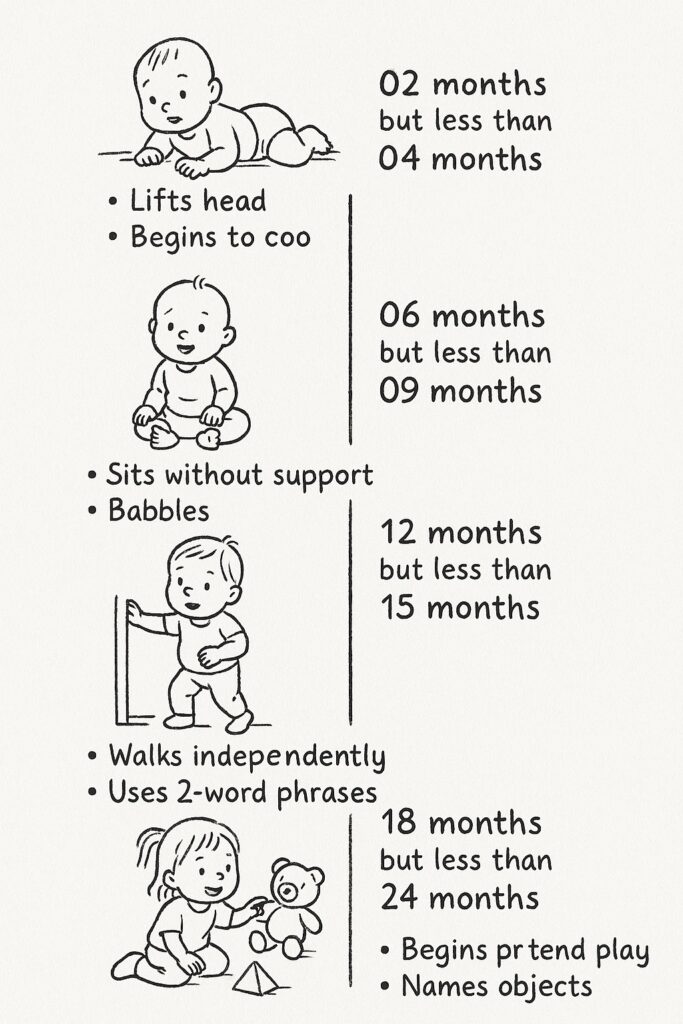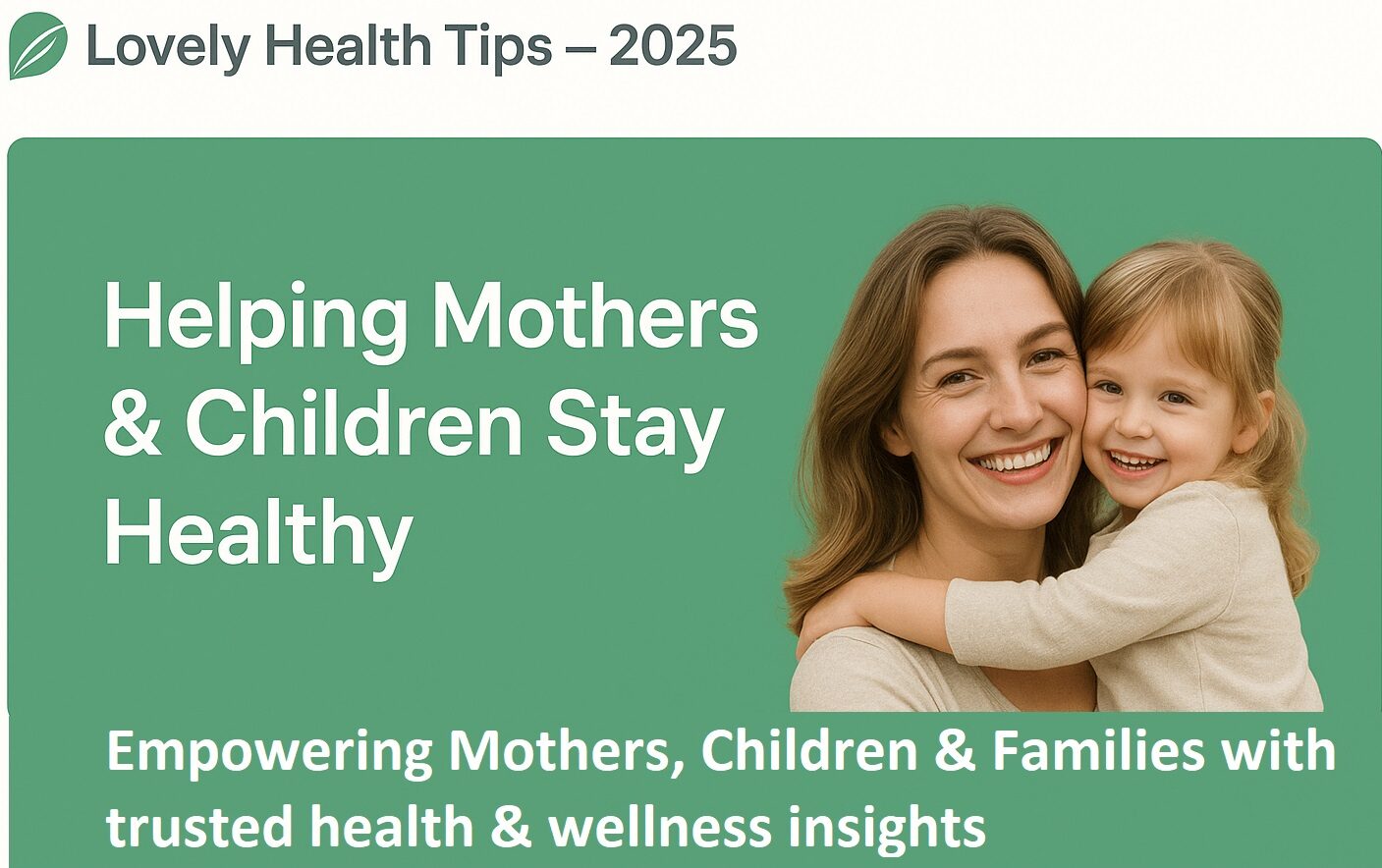Last Updated on October 21, 2025 by
Early Childhood Development:
A. Early Childhood Development : 02 months but less than 04 months
(if child is not doing below mentioned activities, s/he should be consulted with Doctor) :
- By three months, the child keeps his or her hands open and relaxed most of the time, elevates his or her head briefly when lying face down, and movements both arms and both legs freely and evenly when awake or agitated.
- If you speak, the child will react, become alarmed by loud sounds or notice new noises by either smiling or getting quiet.
- At this stage, a child observes the one who takes care of him/her and tries to speak in other sounds other than crying.
- Sucks and swallows properly while feeding, meaning there is no choking.
- From this point, your baby smiles happily at you because they sense your happiness.
B. 04 months but less than 06 months (if child is not doing below mentioned activities, s/he should be consulted with Doctor) : Early Childhood Development
- She holds her head upright when she is taking a seat.
- S/he continuously grabs for something (should use both hands).
- Turns to watch the mother when she talks to the child.
- Pops, chuckles or bursts of laughter.
- A child uses his or her eyes to follow an object.
- Sucks their hands.
C. Recognizing Early Childhood Development : 06 months but less than 09 months (if child is not doing below mentioned activities, s/he should be consulted with Doctor) :
- Either way, the child rotates or rolls over.
- Holding a small object, the child uses both hands and places it right in the center of their palms.
- When you whisper behind them, the child will turn his or her head or eyes to find the source of the voice. Responding consonants viz. p, b, m etc.
- When a baby is in front of the television or playing with toys, that baby maintains his head in the same position.
- The child raises their hands for the parents to select them.
- A child will attempt to locate anything they knocked off the table.
D. 09 months but less than 12 months (if child is not doing below mentioned activities, s/he should be consulted with Doctor) : Early Childhood Development
1. Baby sits by themselves.
2. S/he moves an object from one hand to the other.
3. His/her reaction to his or her name
4. You can hear babbling explained by saying “ba,” “ba,” “da,” “da,” “ma,” and “ma.”
5. Moving here and there without running into anything.
6. Both hide-and-seek and pick-a-boo interest the child.
E. Early Childhood Development : 12 months but less than 15 months (if child is not doing below mentioned activities, s/he should be consulted with Doctor) :
- A baby moves by getting down on their hands and feet.
- The child can use their thumb and index finger to grasp raisin-sized pieces of food (that’s called kismis).
- You tell a child no, the child will stop his/her activity.
- Child may speak a meaningful word like kaka, daba, baba etc.
- They learn to kiss, clap and say their own version of goodbye.
- The offspring produce cries due to being carried by new people.
- A child looks for all of the hidden objects.
F.15 months but less than 18 months (if child is not doing below mentioned activities, s/he should be consulted with Doctor) : Early Childhood Development
- A child walks by themselves.
- A child engages in play by placing little items or objects into a cup or katori.
- By saying “Where is the bottle?” we give kids a chance to explain where it is.
- At this stage the child understands and follows one-step instructions to sit down.
- They demonstrate understanding using at least two words and phrases, though their words may not be yet. (Early Childhood Development)
- By tugging a toy with the fingers, a child begins to understand how it works.
G. Early Childhood Development – 18 months but less than 24 months (if child is not doing below mentioned activities, s/he should be consulted with Doctor) :
- Even with a toy held in their hand, the child manages to walk normally.
- Child draws on the spot
- The child maintains a vocabulary of at least five terms although the words might be challenging to understand.
- Children copy their caregivers by trying to sweep and do laundry themselves.
- When they raise their nose, the child uses one finger to connect two body parts.
H. 24 months but less than 30 months (if child is not doing below mentioned activities, s/he should be consulted with Doctor) : Early Childhood Development
- The child climbs both downstairs and upstairs.
- They use a spoon when feeding themselves or simply use their hand.
- Now, children are able to produce statements such as “mama-milk” and “car-go.”
- The youngster plays with other kids.
- You’ll find that the child likes to play pretend with the doll by acting like they are feeding it.

FAQs:
Q1.What occurs within the 2-month to 30-month period defines critical child growth?
Ans. A child’s incredible growth occurs through rapid development of their brain together with their body as well as emotional and social skills for Early Childhood Development.
Q2. The main physical developments that occur throughout 2–30 months of a child’s life include various achievements.
Ans. The physical developmental milestones of head lifting occur between 2–4 months while sitting up happens from 6–9 months followed by walking at 12–15 months before the child learns to run and climb at 18–30 months.
Q3. Which specific strategies enable parents to help their children develop emotions during the 2–30 months period?
Ans. The process of nurturing emotional growth becomes possible through giving steady affection along with treating child needs softly and by supporting playful activities and creating flexible yet firm limits that help develop trust therefore achieving security for Early Childhood Development.
Q4. The contributions of nutritional factors maintain vital importance when children develop throughout their infancy.
Ans. A correctly chosen diet provides the necessary fuel for brain advancement alongside immune system enhancement and helps a child grow physically. Children need a healthy mixture between proteins and healthy fats together with adequate vitamins and mineral and nutritional protein intake to achieve appropriate growth during this fast development period.
Q5. What significance does playtime hold for children during their second month of lives through their thirty months of age?
Ans. Play enables children to acquire motor skills, social competences, emotional toughness and creative abilities together with problem-solving capabilities. Even simple games like peek-a-boo and building blocks aid in important development for kids.
Q6. How do parents encourage normal language & Early Childhood Development in their children?
Ans. It is important to sing while reading aloud to your child, talk about what you do and respond when they make any sounds if they have Global Developmental Delay.
Q7. Does parents consult their doctor, if their child isn’t hitting the developmental goals for their age?
Ans. Yes, Patients or parents should check-up to a doctor or pediatrician.
Guideline of WHO – Improving Early Childhood Developmental – link as mentioned below: https://iris.who.int/bitstream/handle/10665/331306/9789240002098-eng.pdf
Thanks and Regards
About the Author – “Mr. Bibhu Ranjan Mund”, Master in Public Health (MPH) from IIHMR University, Jaipur (Rajasthan) has experience of 18 years in Public Health activities. Through “Lovely Health Tips-2025”, we share the evidence & experienced based health & wellness guides with solutions for every day well-being. More from Author
Disclaimer
This information is suggestive only and not a replacement for medical advice. For more detail, please visit to my website as mentioned below:


3 thoughts on “Early Childhood Development : Nurturing growth in Children (2m to 30m)”